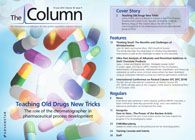Profiling MDMA Impurities Using HS–SPME
Profiling impurities in MDMA (also known as ecstasy) is essential to forensic science as different profiles can provide clues about the source. Two researchers from Michigan State University (Michigan, USA) investigated the effect of liquid–liquid extraction (LLE), headspace solid-phase microextraction (HS–SPME), and different gas chromatography temperature programmes highlighting the need for standardized procedures.
Photo Credit: Andrew Bret Wallis/Getty Images

3,4-methylenedioxy-methamphetamine MDMA (also known as ecstasy) is a widely available synthetic psychoactive drug that can contain a wide range of impurities and cutting agents. Profiling impurities in MDMA is essential to forensic science as different profiles can provide clues about the source. There are a number of standardized extraction and chromatographic methods used by labs; however, it can be difficult to make direct comparisons between data from different sources as key parameters can vary. Two researchers from Michigan State University (Michigan, USA) investigated the effect of liquid–liquid extraction (LLE), headspace solid-phase microextraction (HS–SPME), and different gas chromatography temperature programmes highlighting the need for standardized procedures.1
Ruth Smith, coauthor of the paper, told The Column: “Profiling MDMA exhibits is important to law enforcement so that connections between exhibits and/or manufacturers can be made based on the components and impurities present.” Analysts typically extract MDMA samples using LLE or HS–SPME and analyze by performing gas chromatography–mass spectrometry (GC–MS). According to Smith, however, there is more of a push for statistical analyses to reduce subjectivity, thereby increasing the need for a standardized method.
Five exhibits of MDMA were provided by the Michigan Forensic Science Division. Seven tablets from each exhibit were prepared by LLE and HS–SPME and analyzed using GC–MS with two different temperature programmes. Principle component analysis was performed to statistically assess chromatograms.
It was found that HS–SPME extracted more compounds than LLE because of the preconcentration step. For example, pheny‑2‑propanone (P2P), a common precursor, and the intermediate MDP2P, present when isosafrole or piperonal are used as the starting material, were present in HS–SPME extractions but not LLE. Furthermore, a longer temperature programme of 53 min compared to 36 min gave a higher level of discrimination because of a longer hold time. However, this may not be an option for forensic laboratories and an intermediate may have to be found, according to the paper. Smith told The Column: “This work is important as it may be the first step towards a more standardized approach to impurity profiling.” — B.D.
Reference
1. K.M. McManaman and R. Waddell Smith, Journal of Forensic Sciences59(2) 327–336 (2014).
This article is from The Column. The full issue can be found here

New Method Explored for the Detection of CECs in Crops Irrigated with Contaminated Water
April 30th 2025This new study presents a validated QuEChERS–LC-MS/MS method for detecting eight persistent, mobile, and toxic substances in escarole, tomatoes, and tomato leaves irrigated with contaminated water.

.png&w=3840&q=75)

.png&w=3840&q=75)



.png&w=3840&q=75)



.png&w=3840&q=75)










